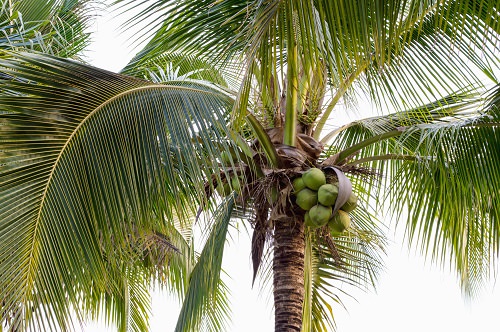Do you know the Difference Between a Coconut Tree and a Palm Tree? If not, then this article will clear out the details!
Coconut Tree vs Palm Tree is quite a debate and most of us don’t have any clarity between their similarities or the areas where they differ from each other. Let’s have a look at the Differences Between a Coconut Tree and a Palm Tree.
Check out the Difference Between Sunpatiens & Impatiens here
What is a Palm Tree?

Palm trees are from the Arecaceae family and are native to South America, the Caribbean, and Asia. Around 2600 species of palms spread over 181 genera and can be distinguished by evergreen, large, compound fronds or leaves arranged on the top of the stem.
These trees differ from having squat, thick trunks covered in scales. Palm produces both fruits and blooms.
How Deep are Palm Tree Roots? Learn here
What is a Coconut Tree?
 Native to Malaysia, Southeast Asia, Indonesia, and some pacific islands, coconut is related to the Arecaceae family and grows in a warm and humid climate.
Native to Malaysia, Southeast Asia, Indonesia, and some pacific islands, coconut is related to the Arecaceae family and grows in a warm and humid climate.
The fruit comprises three layers—Endocarp is a hard and woody layer surrounding the seed. Exocarp is the green and smooth outermost layer, and mesocarp is the middle fleshy layer of the coconut.
It has a solid thick trunk and grows up to 50-80 feet tall from a swollen base. The stem is light gray, with leaves that are up to up to 7-15 feet in length, pinnately divided, and made of 200-250 leaflets.
Check out the best types of coconut here
Is a Coconut Tree a Palm Tree?

Though it sounds contradictory, a coconut tree is a kind of palm tree, but all palm trees can not produce coconuts. A coconut tree is a member of the palm tree family (Arecaceae).
They have similar fan-like fronds that grow outwards from a single point. Both of them have significant differences in size, height, and thickness.
Difference Between a Coconut Tree and a Palm Tree

It is believed that all palm trees are coconut trees, though only a particular species of palm trees carry coconuts. The main difference is in the foliage—palm trees have fan-shaped fronds, whereas coconut trees feature wide leaves. Besides, coconut trees produce coconuts, and palm trees offer palm oil.
Coconut Tree
- Produces coconut fruit
- Has wider foliage
- According to botanists, coconut trees live for 60-80 years. But it has the ability to support three generations. It has slow growth and carries fruits between 6-10 years.
- These trees have deeper roots.
- Coconut trees grow best in hot and wet tropical climates. They need sufficient moisture and warmth to grow well.
Palm Tree
- Produces palm oil
- Has fan-shaped leaves
- Some palm trees live for up to 150 years. On average, they have a lifespan of between 7-8 decades. Some palms survive more than a century.
- The roots sprawl on the base and have a shallow structure
- It does well in warm tropical climatic conditions. However, it is hardy and survives in various climatic conditions. The palm trees get easily affected by cold temperatures in winter.


